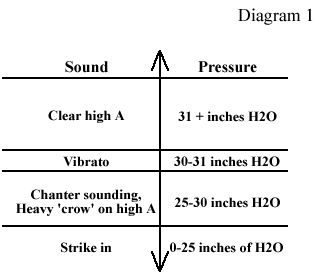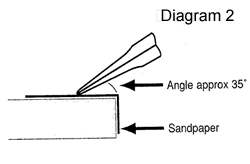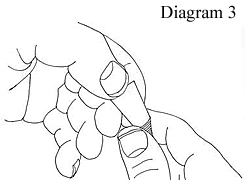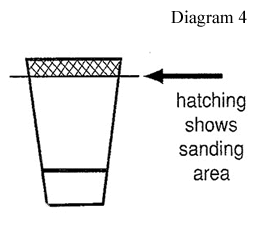From the archives: How to achieve that elusive high A
From time to time, we’ll make subscriber-only articles from our archives available to all readers. Here’s a great piece originally published in November 2008 by reedmaker Chris Apps. There are thousands of feature articles, interviews and reviews in our archives, so be sure to subscribe to access them all.
That elusive high A
By Chris Apps

There are lots of trends and preferences concerning the high A sound produced from the Highland bagpipe. Preferences range from totally clear, almost ethereal in sound, to something that resembles a Harley-Davison gunning down a gravel road with flat tires and no exhaust.
I am often confronted by other non-piping musicians who, when they find out that I play the bagpipes, proceed to sing me the scale thus; do re mi fa so la ti SCREEEEECH! After they stop coughing they pull a face as if to say, “What’s all that about?” I have to admit that at times I ask myself the same question.
The high A preference is a personal choice and is to an extent dependent on the reed being played. Sometimes the scale sounds great, but the reed just doesn’t give the desired high A. Conventional wisdom says “don’t mess with it” – or words to that effect. There are, however, some adjustments that can be made to improve the sound of this elusive note. Whether you have a high A that is too rough or one that is too smooth there are some adjustment techniques that can make a big difference.
Some players produce a beautiful vibrato. This is achieved with a high A that would be otherwise described as rough but is played in the pressure window just above the croak and just below the clear high A. Producing this sound calls for some very steady blowing at the exact pressure. Diagram 1 outlines this pressure window.

At times the high A is just too rough-sounding for proper control to be exerted on the reed, and a clear high A is the preferred sound. In this instance the crow must be reduced or completely removed to make it more manageable and easier on the ear. There are a couple of techniques for doing this.
1. Take the reed and sand just the very tips on a flat surface with very fine sandpaper – 320 grit or above will work. Hold the reed at an angle of around 30-degrees and wipe each side of the reed once. Re-test in the pipes and repeat if necessary taking care not to sand through the tips. See Diagram 2.
 2. Drag your thumbnail across the tip of the reed at an angle to avoid chipping the edge. This will scuff up the edge producing the same result. Ensure that you scrape in one direction only. Do this to both blades once and check in the pipes. Repeat as often as necessary until the desired sound is reached. See Diagram 3.
2. Drag your thumbnail across the tip of the reed at an angle to avoid chipping the edge. This will scuff up the edge producing the same result. Ensure that you scrape in one direction only. Do this to both blades once and check in the pipes. Repeat as often as necessary until the desired sound is reached. See Diagram 3.
 If the high A is considered to be a little too thin, then another approach is needed. First, check the reed to ensure the gap between the blades is sufficient. This isn’t an exact science, but a thin sharp top-hand, especially the high G, is an indicator that the mouth of the reed is too closed. An overall sharpness to the sound and lack of volume is also an indication.
If the high A is considered to be a little too thin, then another approach is needed. First, check the reed to ensure the gap between the blades is sufficient. This isn’t an exact science, but a thin sharp top-hand, especially the high G, is an indicator that the mouth of the reed is too closed. An overall sharpness to the sound and lack of volume is also an indication.
If this is the case, open the mouth of the reed a little with a mandrel. Using a mandrel may make the reed a wee bit harder. If this happens follow the sanding technique outlined in the next paragraph. The sanding will not only ease the reed strength, but will encourage the high A to produce a fuller sound. It’s important to mention here that the following sanding techniques are not recommended for a ridge-cut reed, but work well only with a molded reed.
 Once the mouth is set to the correct size the tips of the blades will need to be thinned a little to encourage the top hand to project a bit more. When thinning the blades, carefully sand the top 1/8th to 3/16th inch down from the tips. This must be done with great care on a flat surface with fine sandpaper. Make sure that the reed isn’t angled as the tips will very quickly sand through. This will make the reed easier and give the top hand a fuller sound. See Diagram 4.
Once the mouth is set to the correct size the tips of the blades will need to be thinned a little to encourage the top hand to project a bit more. When thinning the blades, carefully sand the top 1/8th to 3/16th inch down from the tips. This must be done with great care on a flat surface with fine sandpaper. Make sure that the reed isn’t angled as the tips will very quickly sand through. This will make the reed easier and give the top hand a fuller sound. See Diagram 4.
Once adjustments have been made, test the reed in the pipes. If the reed is still a little thin on top and doesn’t yet vibrate efficiently, repeat until the reed improves. It’s a matter of checks and balances: open up here and take away there.
Remember, all is not lost if your reed doesn’t produce your preferred top-hand sound right away. Try some of these techniques. You might be surprised at the difference a few small changes will make.
A top-flight piper originally from England, Chris Apps now lives in Union, Missouri, and is a full-time reedmaker, chanter manufacturer and piping supplies dealer through his business, Apps Reeds.


Cool! I just tried it and it works!
Listen to Alastair Gillies’s High A on several tracks of his new album Loch Broom” – That’s a High A. That’s a set of pipes. “
Both pipers are on sheepskin, is this more to do with the High A than reed manipulation????
I think its a combiation of the both….
I find that a simple approach to a good reed with a strong crow is to squeeze it a few times. The pitch on the high hand goes up and the crow subsides. Ken
To be honest i think it has alot to do with the choice of reed and of course you must play a sheepskin bag and cane drone reeds.
A good article I thought!
As soon as I changed from a Canister system with a Ross bag, over to a goatskin bag with a stitched seam, the exact same reed and chanter combination produced a vibrato on High A. This never happened with the Ross bag etc. My experience is that the stitched seam bags resonate more than the glued seam types, and the kinked neck of a stitched seam is a big factor in producing the High A in question here. Glued seam bags (either hide or Synthetic) have ‘perfect’ necks that are wider and this is another big factor. The kink in the neck of a stitched bag, plus the natural resonation it encourages, are the two biggest factors. Blowing is part of the equation, BUT ONLY when the right bag is used. Weaker solo reeds tend to produce a more pronounced vibrato on High A. People often confuse a pleasant sounding vibrato with a scratchy craw. They are quite different. A craw is usually a sign of a poor reed, poor blowing and/or poorly balanced chanter………and usually all of the above.